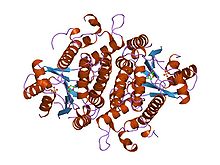Thymidine kinase from herpesvirus
| Thymidine kinase from herpesvirus | |||||||||||
|---|---|---|---|---|---|---|---|---|---|---|---|
 Structure of thymidine kinase from herpesvirus.[1] | |||||||||||
| Identifiers | |||||||||||
| Symbol | Herpes_TK | ||||||||||
| Pfam | PF00693 | ||||||||||
| InterPro | IPR001889 | ||||||||||
| SCOP2 | 1kin / SCOPe / SUPFAM | ||||||||||
| |||||||||||
Thymidine kinase from herpesvirus is a sub-family of thymidine kinases.[2]
Its presence in herpesvirus-infected cells is used to activate a range of antivirals against herpes infection, and thus specifically target the therapy towards infected cells only.
Such antivirals include:
- Purine analogues of guanine: Aciclovir, Famciclovir, Ganciclovir, Penciclovir, Valaciclovir, Valganciclovir
- Vidarabine
- Pyrimidine analogues of uridine: Idoxuridine, Trifluridine
- Brivudine
Mutations in the gene coding thymidine kinase in herpes viruses can endow the virus with resistance to aciclovir. In these situations, alternative medications that are of use include other guanine analogues such as famciclovir, valaciclovir and penciclovir.
References
- ^ Champness JN, Bennett MS, Wien F, et al. (August 1998). "Exploring the active site of herpes simplex virus type-1 thymidine kinase by X-ray crystallography of complexes with aciclovir and other ligands". Proteins. 32 (3): 350–61. doi:10.1002/(SICI)1097-0134(19980815)32:3<350::AID-PROT10>3.0.CO;2-8. PMID 9715911.
- ^ Brown DG, Visse R, Sandhu G, Davies A, Rizkallah PJ, Melitz C, Summers WC, Sanderson MR (October 1995). "Crystal structures of the thymidine kinase from herpes simplex virus type-1 in complex with deoxythymidine and ganciclovir". Nat. Struct. Biol. 2 (10): 876–81. doi:10.1038/nsb1095-876. PMID 7552712. S2CID 3223579.
